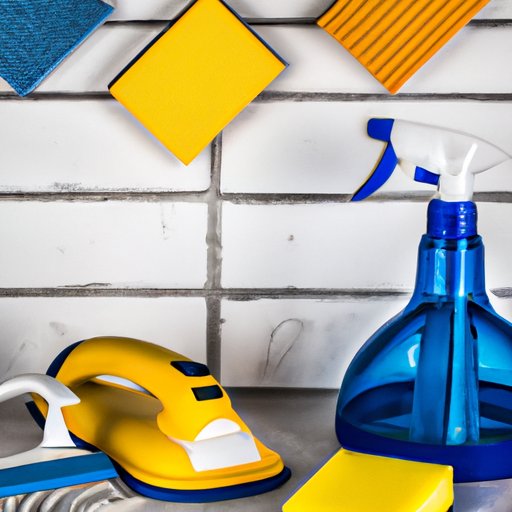Introduction
Painting can be a daunting task, especially if you don’t know where to start. One of the most important steps in the painting process is cleaning the walls. If the walls are not properly cleaned, the paint may not adhere correctly or last as long as it should. This article will provide detailed instructions on how to properly clean walls before painting.
Vacuuming the Walls
The first step in cleaning walls before painting is to vacuum them. Vacuuming the walls removes any dust and dirt that has accumulated over time. This ensures that the walls are free of debris before applying the paint. There are several benefits to vacuuming the walls. It helps remove dirt, dust, and pet hair that could interfere with the painting process. It also prevents small particles from getting into the paint, which can cause bubbles or uneven coverage.
When vacuuming the walls, make sure to use a soft brush attachment to avoid damaging the surface. Start by vacuuming along the baseboards and then move up the wall in sections. After vacuuming the walls, be sure to vacuum the floor to pick up any debris that may have fallen during the process.
Wiping Down the Walls
Once the walls have been vacuumed, the next step is to wipe them down. This is done to remove any remaining dust and dirt that was not removed by the vacuum. Wiping down the walls also helps remove any grease or grime that may have built up over time. This ensures that the walls are clean and ready for painting.
To wipe down the walls, start by dampening a cloth with warm water. Gently wipe down the walls in sections, starting at the top and working your way down. Be sure to rinse the cloth often to prevent dirt and dust from being spread around. Once the walls have been completely wiped down, allow them to dry before moving on to the next step.
Using a Mild Detergent Solution
If the walls are especially dirty or greasy, a mild detergent solution may be necessary. A mild detergent solution is a combination of detergent and water. This mixture can help break down dirt and grease, making it easier to remove. When using a mild detergent solution, be sure to wear gloves and safety glasses to protect yourself from any splashes.
To prepare the solution, mix one teaspoon of mild detergent with one gallon of warm water. Dip a sponge or cloth into the solution and wring out the excess. Begin at the top of the wall and work your way down in sections. After wiping down the walls with the detergent solution, rinse them with clean, warm water and allow them to dry before continuing.
Using an All-Purpose Cleaner
If the walls are in need of a deep clean, an all-purpose cleaner may be necessary. An all-purpose cleaner is a stronger solution than a mild detergent and can help remove more stubborn dirt and grease. When using an all-purpose cleaner, be sure to wear gloves and safety glasses to protect yourself from any splashes.
To prepare the solution, mix one tablespoon of all-purpose cleaner with one gallon of warm water. Dip a sponge or cloth into the solution and wring out the excess. Begin at the top of the wall and work your way down in sections. After wiping down the walls with the all-purpose cleaner, rinse them with clean, warm water and allow them to dry before continuing.
Using Sandpaper
In some cases, sanding the walls may be necessary to remove any imperfections or bumps. Sanding the walls helps create a smooth surface that is ready for painting. When sanding the walls, use a medium-grit sandpaper and sand in small circles. Be sure to wear a dust mask and safety glasses when sanding to protect yourself from any dust or debris.
After sanding the walls, use a damp cloth to wipe away any dust or debris. Allow the walls to dry before continuing. Once the walls have been sanded and wiped down, they are now ready for painting.
Conclusion
Cleaning walls before painting is a crucial step in the painting process. The goal is to remove any dirt, dust, grease, or grime that may interfere with the paint adhering correctly. To do this, start by vacuuming the walls and then wiping them down. If the walls are especially dirty, a mild detergent solution or an all-purpose cleaner may be necessary. Lastly, if there are any bumps or imperfections, sand the walls with a medium-grit sandpaper. Following these steps will ensure that the walls are clean and ready for painting.
Final Thoughts
Cleaning walls before painting is an important part of the painting process. It ensures that the paint will adhere correctly and last as long as possible. By following the steps outlined in this article, you can easily clean your walls and get started on your painting project.


